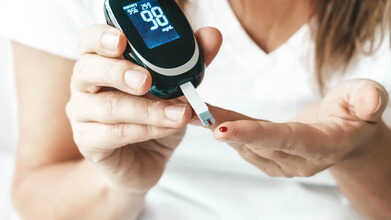- Health Conditions A-Z
- Health & Wellness
- Nutrition
- Fitness
- Health News
- Ayurveda
- Videos
- Medicine A-Z
- Parenting
- Web Stories
Aspirin Isn’t Always Safe For Older Adults Anymore—Here's Why Doctors Are Warning Against It

Credits: Canva
For decades, a daily low-dose aspirin was the go-to prescription for heart disease prevention. The tiny pill was considered a low-effort, high-reward approach to keeping heart attacks and strokes at bay. But recent research and evolving guidelines are prompting doctors to pump the brakes, especially when it comes to older adults.
Historically, aspirin’s blood-thinning properties made it a staple for preventing blood clots, which are a major cause of heart attacks and strokes. This practice, known as "primary prevention," targeted people who had not yet experienced a cardiovascular event but were considered at risk due to age or other factors. A typical dose hovered around 81 milligrams per day.
For individuals with a history of cardiovascular disease, aspirin’s benefits still hold. That’s "secondary prevention," and most experts still endorse it. But for older adults with no prior heart issues, new studies are revealing a more complicated risk-benefit balance.
Also Read: First UK Adult To Receive Treatment For Type 1 Diabetes Drug Undergoing Trials
Newer clinical trials and large-scale studies began to challenge the once-universal recommendation. They found that for many older adults, particularly those over 60 or 70 without a history of heart disease, the risk of serious bleeding outweighed the potential cardiovascular benefits.
As a result, leading health organizations have revised their guidelines:
The American College of Cardiology (ACC) and American Heart Association (AHA) advise against daily aspirin for primary prevention in adults over 70.
The U.S. Preventive Services Task Force (USPSTF) recommends against starting low-dose aspirin for primary prevention in adults over 60, and suggests a case-by-case approach for those aged 40-59 who have a 10% or greater 10-year cardiovascular risk.
What Are The Hidden Risks Of Taking Aspirin?
Aspirin is a nonsteroidal anti-inflammatory drug (NSAID) that reduces inflammation and prevents platelets from clumping together. But this same mechanism that reduces heart attacks also raises the risk of internal bleeding, particularly in the gastrointestinal (GI) tract and brain.
Older adults are already more vulnerable to GI bleeding and hemorrhagic strokes. When aspirin is added to the mix, the potential for serious, sometimes fatal, complications increases.
According to Dr. Jordan Schaefer, a hematologist at the University of Michigan Medical School, "For some patients without a history of cardiovascular disease, the benefits of taking aspirin may be offset by an increased risk of bleeding, especially as patients get older."
Also Read: Why Does Your BBL Smell? Doctor Explains 4 Reasons That Could Cause It
A recent study published in the Journal of the American College of Cardiology surveyed over 2,500 adults between the ages of 50 and 80. It found that:
- About 1 in 6 older adults still take daily aspirin for primary prevention.
- Nearly 25% started aspirin use without a physician’s recommendation.
- Only 68% were aware that aspirin increases the risk of bleeding.
- Nearly 30% believed aspirin could reduce the risk of dementia.
Younger respondents (aged 50-69) were twice as likely to use aspirin for primary prevention compared to those aged 70-80. Women and individuals with household incomes over $60,000 were also more likely to take aspirin preventatively.
Dr. Mark Edwards, an internal medicine resident at University of Michigan Health and lead author of the study, pointed out that many patients believe aspirin offers wide-ranging health benefits, not just heart protection. "It appears that older adults taking aspirin may anticipate benefits beyond reducing the risk of cardiovascular disease and may not fully understand the added risk of bleeding," he said.
Why Many Still Take Aspirin Without Doctor Guidance?
Old habits die hard. For years, media campaigns and public health messaging endorsed the idea of a daily aspirin. Even today, some doctors haven’t updated their advice, and many patients continue on autopilot.
Adding to the confusion, aspirin is available over-the-counter and has a reputation for being "harmless." Aspirin use is much more of a complex question than it once seemed, which is all the more reason why it is important to consult a health care provider when considering use.
What Should Patients Over 40 Do?
If you're over 40, the advice isn't to automatically start or stop aspirin. It's to have a thoughtful conversation with your doctor about your individual risk. Risk assessments often include:
- Personal and family history of heart disease
- Blood pressure and cholesterol levels
- Smoking status
- Diabetes or prediabetes
- Other medications that may increase bleeding risk
Based on these factors, your doctor may calculate your 10-year risk of cardiovascular disease and guide your decision.
What About People Already on Aspirin?
If you’re over 60 and taking aspirin without a prior cardiovascular event, it’s time to revisit the plan. Do not stop abruptly without consulting your physician, especially if you have a stent, history of stroke, or previous heart attack.
Experts recommend, anyone over 40 should talk to their provider about their risk for cardiovascular disease, with careful consideration of family and health histories.
Aspirin isn’t a one-size-fits-all preventive tool anymore. For many healthy older adults, the risks outweigh the benefits, particularly when it comes to internal bleeding. Still, for those with a documented history of cardiovascular disease, aspirin remains a cornerstone of secondary prevention.
Skip the DIY health decisions, talk to your doctor before starting or stopping any daily aspirin regimen. What once seemed like a harmless habit could be doing more harm than good.
New Study Suggests Targeting Belly Fat Can Prevent Prediabetes

Credits: Canva
Where fat accumulates in the body can be far more important than simply shedding pounds when it comes to lowering diabetes risk, a new study published in Nature suggests. For people with prediabetes, which is when blood sugar is higher than normal but not yet at diabetes levels, targeting belly fat specifically may have a greater impact than losing weight overall through lifestyle changes.
Halting prediabetes is critical, as nearly 70 percent of individuals in this category eventually develop diabetes. Reversing prediabetes also protects against complications like heart disease, kidney problems, and nerve damage.
What About Study Findings?
In the study, two groups of participants had similar overall fat levels but differed in how fat was stored. Those who lost more belly fat, or visceral fat, over a year were able to reverse prediabetes, while those who didn’t reduce abdominal fat did not reach healthy blood sugar levels.
Researchers from the University Hospital Tübingen in Germany found that focused lifestyle changes could bring prediabetic individuals into remission even without major weight loss. This remission was associated with a roughly 70 percent reduction in the risk of developing Type 2 diabetes over the following decade.
Among 1,105 participants with prediabetes, the study examined 234 individuals who did not lose overall weight. Of these, 51 achieved prediabetes remission after a year of targeted lifestyle interventions, while the remaining 183 did not reach healthy glucose levels.
Does This Study Hold Lessons for Indians?
“Weight loss remains the primary goal for people who are obese. However, reversing prediabetes can also happen without major weight loss, especially when lifestyle interventions focus on improving diet quality, increasing physical activity, and building muscle while reducing fat,” says Dr. Anoop Misra, chairman at Fortis C-Doc Hospital for Diabetes and Allied Sciences.
He adds that for Indians, reducing both subcutaneous abdominal fat and visceral fat is key for better metabolism. These changes, paired with increased muscle mass and improved functional capacity, enhance insulin sensitivity and help maintain long-term blood sugar control.
Why Abdominal Obesity Is a Priority
Belly fat, or visceral fat, releases inflammatory substances that interfere with insulin, the hormone that moves sugar from the blood into cells. To compensate, the body produces more insulin, which can overwhelm the pancreas and raise blood sugar. Excess sugar is often stored as fat around the abdomen, which is why even individuals of normal weight with a protruding stomach are at higher risk of diabetes.
What Lifestyle Interventions Help Reduce Belly Fat?
“Diet composition matters most lower carbs, higher protein, and healthy fats, all within a controlled calorie range, can help reverse prediabetes even without significant weight loss,” says Dr. Misra. Good carbohydrate sources include whole grains, fruits, legumes, and non-starchy vegetables, while healthy fats come from nuts, seeds, olive oil, and fatty fish.
Physical activity also plays a crucial role. Combining resistance training, such as weightlifting at least twice a week, with aerobic exercises like walking, running, or swimming, is effective at reducing visceral fat. Adequate sleep around seven hours per night is also essential to keep blood sugar levels under control.
Google Vs Chat GPT: Study Finds Which Medium Give Better Health Advice

(Credit-Canva)
Search engines like Google and Bing, and AI chatbots like ChatGPT and GPT-4, are now major sources of health information. But how reliable are they?
A new research published in the NPJ Digital Medicine tested four major search engines and seven different large AI models, including leading programs like ChatGPT and GPT-4, by asking them 150 medical questions. Their study looked at how accurate the answers were, how much the results changed based on how the question was asked, and whether giving the AI access to search results helped.
Which Gave Better Answers: AI or Search Engines?
While AI Chatbots, with 80% accuracy, generally outperformed Search Engines, with 50-70% accuracy, on direct health questions, the study found that AI chatbots are good, but their mistakes are worrying.
Confidence in Errors
The biggest and most dangerous problem was that the AI sometimes gave confidently wrong answers that directly disagreed with established medical facts. This is highly risky in a health setting.
Overall Accuracy
The AI chatbots generally did better than search engines, correctly answering about 80% of the questions. The best performers were typically GPT-4, ChatGPT, Llama3, and MedLlama3.
Precision Problem
Search engines like Google usually return answers that are correct when they directly address the question, but they often clutter the results with information that is incomplete or off-topic. They struggled with giving a straight "yes" or "no" answer.
User Habits
The study simulated a "lazy" user, who just trusts the first answer, and a "diligent" user, who checks three sources. Surprisingly, the "lazy" users were sometimes just as accurate as the diligent ones, suggesting that top-ranked results are often good, but this is a risk if a highly ranked answer happens to be wrong.
Bing was the best among search engines, but it wasn't significantly better than Google, Yahoo!, or DuckDuckGo.
How You Ask The Question Matters
The AI's accuracy was highly sensitive to how the question was phrased. Using an "expert" prompt like asking the AI to cite reputable medical sources generally led to better, more medically sound answers, even if they were sometimes less direct.
Giving the AI the top search results before it answered (retrieval augmentation) usually improved performance, especially for smaller AI models. However, this didn't always help; if the search results given to the AI were irrelevant or low-quality, the AI's answer could actually get worse. More information isn't always better.
Things to Keep In Mind
Some points noted by the researchers was,
- Questions about COVID-19 were easier for both AI and search engines, likely because of the huge amount of data available about the pandemic.
- While AI is powerful, its tendency to be swayed by how you word the question and its confident errors mean we need to be very cautious about using it for medical advice.
- The overall conclusion is that AI models are promising for health information, but they are not yet fully reliable on their own. Combining them with high-quality search results is likely the best way forward, but only if the search results fed to the AI are trustworthy.
Eye Movement Tracker Can Reveal The Risk Of Alzheimer's Years Before Symptoms Appear: Study

(Credit-Canva)
A recent scientific study found an exciting new way to check if someone is likely to get Alzheimer's disease due to their genetics. Instead of current medical tests, which are often costly, complex, and invasive, this new method uses simple eye-tracking technology. This means diagnosing the risk could become much easier for patients and more affordable for healthcare systems.
As you may know, there is currently no cure for Alzheimer's disease. This is a neurodegenerative disease that can affect a person’s memory, skills, as well as behavior. The best way to deal with this disease is by diagnosing it early, so that doctors can provide medicine and treatment options to delay the onset and manage the symptoms. However, it is not easy to spot the symptoms, so how can one know for certain whether they have Alzheimer's disease or not?
How Can Eye Trackers Detect Alzheimer’s Disease
This research, which involved scientists from the University of Strathclyde, looked closely at how well this new technique works. The technology is a specific system called ViewMind Atlas. It works by monitoring a person's tiny, subtle eye movements. Then, Artificial Intelligence (AI) software analyzes these movements.
Since the eyes are closely linked to the brain, the way they move can tell doctors about the brain's health and function. The most important part is that this system can successfully identify the genetic risk in people years before they start showing any actual memory loss or other Alzheimer’s symptoms.
How Accurate Is This Eye Tracking Test?
To test the system, the researchers studied a group of people from extended families in Colombia who have a known genetic mutation that causes Alzheimer’s. The results were incredibly promising:
For the family members who were already showing symptoms of the disease, the ViewMind Atlas test was 100% accurate in identifying them.
More remarkably, for those who carried the gene but didn't have any symptoms yet (asymptomatic), the test was 96% accurate at correctly identifying their risk. The AI model essentially learned to look at the patterns of eye movement and use them to tell apart the people who had or were likely to get Alzheimer's from those who weren't.
Can This Help Improve Early Diagnosis Rate?
The research team found this eye-tracking test detects the disease earlier than standard cognitive tests, which often fail to flag a problem until it is well underway. The lead scientist, Professor Mario Parra Rodriguez, explained why this is such a big deal. He pointed out that today's common tests are "expensive and invasive," often requiring hospital procedures.
The ViewMind Atlas system, however, helps doctors predict Alzheimer’s risk years in advance. This is key for doctors, who often struggle to figure out if a patient’s mild forgetfulness is just a normal part of getting older or a serious risk of dementia. This new tool could help them act quickly to treat or manage the risk instead of having to wait for the disease to fully develop.
© 2024 Bennett, Coleman & Company Limited

